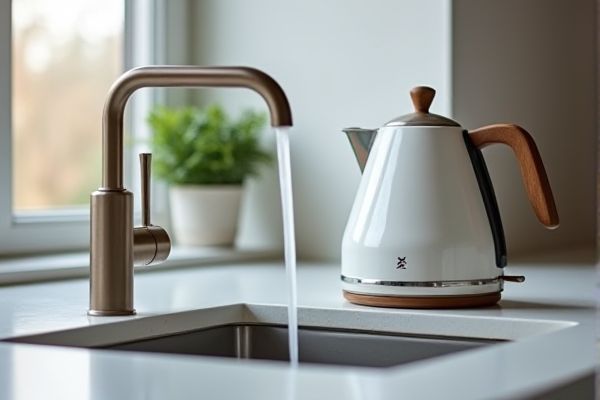
A boiling water tap offers instant access to near-boiling water, saving time and energy compared to a standard kettle that requires waiting for water to heat. Discover how choosing the right option can enhance Your kitchen convenience by reading the rest of this article.
Table of Comparison
| Feature | Boiling Water Tap | Standard Kettle |
|---|---|---|
| Heating Method | Instant boiling via built-in heating element | Electric or stovetop heating |
| Boiling Time | Instant, usually within seconds | 2-5 minutes depending on volume and power |
| Capacity | Continuous supply, limited by tap flow | Typically 1-2 liters per boil |
| Installation | Requires plumbing and electrical setup | Plug and play, no installation needed |
| Energy Efficiency | Efficient for small, instant amounts | May use more energy heating full volume |
| Cost | High initial purchase and installation cost | Lower upfront cost |
| Safety Features | Child locks, safety taps common | Often auto shut-off and boil dry protection |
| Maintenance | Requires periodic descaling and servicing | Easy cleaning, less maintenance |
| Best Use Case | Frequent boiling needs; offices, busy kitchens | Occasional boiling; home kitchens |
Introduction to Boiling Water Taps and Standard Kettles
Boiling water taps provide instant, filtered boiling water directly from the faucet, offering convenience and energy efficiency compared to standard kettles. Standard kettles require manual filling and waiting for water to boil, which can consume more electricity and time. Both appliances serve to boil water, but boiling water taps integrate seamlessly into kitchen workflows for faster access.
How Boiling Water Taps Work
Boiling water taps instantly heat cold water using an internal filtration and heating system, providing near-boiling water on demand without the need to wait for a kettle to boil. These taps utilize rapid heating elements, often connected to a dedicated water line, ensuring continuous supply and energy efficiency compared to repeatedly heating a kettle. The integration of insulated tanks or direct heating technology enables precise temperature control and reduces water wastage, making boiling water taps a convenient and sustainable alternative to standard kettles.
How Standard Kettles Work
Standard kettles heat water by using an internal electric heating element or a stovetop heat source, which rapidly raises the water temperature until it reaches boiling point. These kettles require manual monitoring to prevent overheating or running dry, as they rely on the user to switch them off at the right time or automatically shut off when boiling is detected. Choosing between a boiling water tap and standard kettle depends on your preference for speed, convenience, and energy efficiency.
Installation and Setup Comparison
Boiling water taps require professional installation involving plumbing and electrical work to ensure safety and proper function, while standard kettles simply need to be plugged into an electrical outlet for immediate use. The setup time for boiling water taps is longer due to the integration with your kitchen sink and water supply, contrasting with the quick, portable nature of kettles. Your choice depends on whether you prioritize a seamless, built-in solution or a convenient, ready-to-use appliance without installation hassle.
Energy Efficiency: Tap vs Kettle
Boiling water taps offer superior energy efficiency compared to standard kettles by heating only the exact amount of water needed instantly, reducing energy waste. Standard kettles often boil excess water, consuming more electricity and increasing costs. Choosing a boiling water tap can lower your energy consumption and environmental impact significantly.
Convenience and Speed of Use
A boiling water tap delivers instant hot water directly from the faucet, eliminating the wait time needed to boil water in a standard kettle. This instant access enhances convenience, especially during busy mornings or when you need to prepare multiple hot drinks quickly. Your kitchen routine becomes more efficient, saving both time and effort compared to the traditional kettle.
Safety Features and Considerations
Boiling water taps offer advanced safety features such as child locks, insulated spouts, and automatic shut-off functions, reducing risks compared to standard kettles that often lack these protections. Standard kettles may pose burn hazards due to exposed hot surfaces and steam release without safety interlocks. Your choice should prioritize these safety features to prevent accidents in busy or family-oriented kitchens.
Cost and Long-Term Value
A boiling water tap offers higher upfront costs compared to a standard kettle but delivers significant long-term value through energy efficiency and convenience. Standard kettles are less expensive initially but may incur higher energy costs due to frequent boiling cycles and longer heating times. Over time, a boiling water tap reduces water waste and electricity usage, making it a cost-effective investment for households with regular hot water needs.
Environmental Impact Assessment
Boiling water taps consume less energy by heating only the required amount instantly, reducing electricity usage compared to standard kettles that commonly heat excess water. Standard kettles typically use more power per boil and contribute to higher carbon emissions over time, especially with frequent use. The efficiency of boiling water taps supports a lower environmental footprint, making them a more sustainable choice for household hot water needs.
Choosing the Right Option for Your Home
A boiling water tap offers instant hot water directly from your sink, saving time and reducing energy consumption compared to a standard kettle, which requires waiting for water to heat and can use more electricity. Your choice should consider factors like convenience, installation complexity, and budget, as boiling water taps often involve higher upfront costs but provide long-term efficiency. For households prioritizing speed and ease, a boiling water tap is ideal, while a standard kettle remains a simple, portable, and cost-effective solution.
 homyna.com
homyna.com